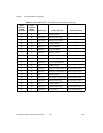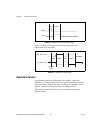Chapter 4 Digital I/O Functionality
NI 1450 Series Compact Vision System User Manual 4-4 ni.com
Timed Pulse Output
The NI 1450 is capable of timed pulse output on six different digital
outputs, which provides precise control over time-critical signals, such as
camera exposure. This section describes the various uses for the timed
pulse output and the parameters you can set to control these outputs.
Uses for timed pulse output include controlling camera reset and exposure,
controlling strobe lighting, operating plungers on an assembly line, and
communicating with PLCs. You can configure the start of the pulse output
generation to occur from software or from a rising or falling edge of a
trigger input.
In addition to controlling the timing of pulse output, you can also configure
the polarity of the output signal, resulting in a high-true or low-true signal.
Based on the polarity setting, the output signal asserts after the appropriate
delay time and de-asserts after the configured pulse width. You can set the
delay time in microseconds or in quadrature encoder counts from the start
signal—either a hardware trigger or a software command. Width is always
configured in microseconds.
Initiating a Timed Pulse
Each timed pulse generator has a trigger input that specifies whether to wait
on a particular trigger input to generate the pulse or to immediately
generate the pulse when software sets the mode to Start.
When the pulse generator is configured for a particular trigger input, after
generating a pulse, it waits for another trigger before generating another
pulse. When the pulse generator is configured to immediately generate the
pulse on a software start, after generating a pulse, it immediately generates
another pulse.
If the trigger input is set to immediate, the pulse generation occurs as soon
as the pulse mode is set to start. If the trigger input is set to one of the
hardware trigger inputs, the timed pulse output waits for an assertion edge
on the appropriate trigger input. The assertion edge is configurable based
on the trigger polarity parameter. It then generates one pulse and rearms to
wait for the next trigger. In either case, the pulse output generation stops
and resets if the pulse mode parameter is set to stop.


















